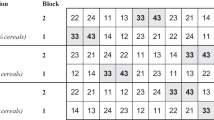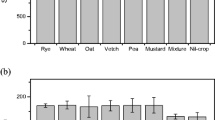Abstract
With the aim of assessing the benefits of crop remains left on the soil surface, a study was carried out on the decomposition and characteristics of residue deposited on a clay soil in southern Spain during the agricultural seasons of 2001/02, 2002/03 and 2003/04, in which a legume-cereal-sunflower rotation was followed. Each of the residues studied possessed a characteristic justifying its inclusion in the rotation. The legume residue (Pisum sativum L. cv. Ideal) supplied the highest amount of nitrogen to the soil since, throughout its decomposition cycle, it lost 76.6% of its initial content in nitrogen, compared to the 48 and 56% of N released by wheat residues (Triticum durum L. cv. Amilcar) and sunflower (Helianthus annus L. cv. Sanbro), respectively. At the beginning of its decomposition cycle, the wheat residue had the lowest mass, and gave the most cover, with values of 65%, which was 8.6 and 20.2% more than the cover estimated for the pea and sunflower residues, respectively. The sunflower residue lasted longest, only losing 18% of its initial cover over 109 days of decomposition, compared to 47% for wheat and 53% for pea. The amount of carbon released was similar for the three residues and was around 500 kg ha−1. The straw decomposition rates under our conditions indicate that the residue of the most common crops in the area under dry farming makes protection possible during the intercrop period.





Similar content being viewed by others
References
Agrela F, Gil JA, Giráldez JV, Ordóñez R, González P (2003) Obtention of reference value in the measurement of the cover fraction in conservation agriculture. In: Cury B, Canalli LB (eds) Proceedings II World Congress on Conservation Agriculture, Iguazú, Brazil
Aulak M, Doran J, Walters D, Mosier A, Francis D (1991) Crop residue type and placement effects on denitrification and mineralization. Soil Sci Soc Am J 55:1020–1025
Buchanan M, King LD (1993) Carbon and phosphorus losses from decomposing crop residues in no-till and conventional till agroecosystems. Agron J 85:631–638
Conservation Tillage Information Center (1990) National survey of conservation tillage practices, Con Till Inf Center, Fort Wayne
Dobermann A, Ping JL, Adamchuk VI, Simbahan GC, Ferguson RB (2003) Classification of crop yield variability in irrigated production fields. Agron J 95:1105–1120
Douglas CL, Rickman RW (1992) Estimating crop residue decomposition from air temperature, initial nitrogen content, and residue placement. Soil Sci Soc Am J 56:272–278
Du B, Bekele A, Morrison JE (2004) Drill furrow opener effects on wheat and sorghum establishment in no-till fields. Appl Eng Agric 20(2):179–185
Ernst O, Betancour O, Borges R (2002) Descomposición de rastrojo de cultivos en siembra sin laboreo: trigo, maíz, soja y trigo después de maíz o de soja. Agrociencia VI(1):20–26
Giráldez JV, González P, Ordóñez R, de Haro JM and Laguna A (1995). Nutrient enrichment and straw evolution under reduced tillage in heavy clay soils of southern Spain. In: Tebrüge F, Böhrnsen A (eds) Proceedings of the EC-Workshop-II. Silsoe, 15–17 May pp 69–81. Giessen, Germany
Gregory JM (1982) Soil cover prediction with various amounts and types of residue. Trans ASAE 25:1333–1337
Jaynes DB, Hunsaker DJ (1989) Spatial and temporal variability of water content and infiltration on a flood irrigated field. Trans. ASAE 32(4):1229–1238
Lal R, Follett RF, Kimble JM, Cole CV (1999) Management of US cropland to sequester carbon in soil. J Soil Water Cons 54:374–381
Lyon DJ (1998) Sunflower residue weight and ground cover during summer fallow. J Soil Water Cons 53(1):71–73
Ma L, Peterson GA, Ahuja LR, Sherrod L, Shaffer MJ, Rojas KW (1999) Decomposition of surface crop residues in long-term studies of dryland agroecosystems. Agron J 91:401–409
Nelson DW, Sommer LE (1982) Total carbon, organic carbon and organic matter. In: Page AL, Miller RH, Keeny DR (eds) Methods of soil analysis, part 2 Chemical and microbiological properties. Agron. N° 9, 2nd edn. American Society of Agronomy, Madison, pp 539–577
Ordóñez R, González P, Perea F, Llanos I, Giráldez JV (2001) The protective role of stubble cover in dry farming conservative agriculture in southwest Spain. In: García L, Benites J, Martínez A (eds) Proceedings of I World Congress on Conservation Agriculture, Madrid
Ordóñez R, González P, Bravo C, Martínez G (2005) Evolution of residue decomposition in corn-cotton-poppy rotation. In: Abstracts of the international congress on conservation agriculture: the challenge of agriculture, the environment, the energy and the new common agrarian policy, Córdoba (Spain), 9–11 November pp 555–560
Ordóñez R, González P, Giráldez JV, Perea F (2007) Soil properties and crop yields after 21 years of direct drilling trials in Southern Spain. Soil Till Res 94(1):47–54
Quemada M (2004) Predicting crop residue decomposition using moisture- adjusted time scales. Nutr Cycl Agrosys 70:283–291
Schomberg HH, Steiner JL (1997) Comparison of residue decomposition models used in erosion prediction. Agron J 89:911–919
Schomberg HH, Steiner JL (1999) Nutrient dynamics of crop residues decomposition on a fallow no-till soil surface. Soil Sci Soc Am J 63:607–613
Slokener LL, Moldenhaucer WC (1977) Measuring the amounts of crop residue remaining after tillage. J Soil Water Conserv 32:231–236
Steiner JL, Schomberg HH, Unger PW, Cresap J (2000) Biomass and residue cover relationships of fresh and decomposing small grain residue. Soil Sci Soc Am J 64:2109–2114
Soil Survey Staff (1999) Soil Taxonomy a basic system of soil classification for making and interpreting soil surveys. USDA Agr. Hdbk. 436, 2nd edn. Washington
Sparks DL, Page AL, Helmke PA, Loccpert RM, Sottanpour PN, Tabatabai MA, Johnston CI, Summer ME (1996) Methods of soil analysis, part 3 ed., chemical methods. Agron. Eds. Nª 5, 3, Am. Soc. of Agron., Madison
Sparrow SD, Lewis CE, Knight CW (2006) Soil quality response to tillage and crop residue removal under subarctic conditions. Soil Till Res 91(1–2):15–21
Thorburn DJ, Probert ME, Robertson FA (2001) Modelling decomposition of sugarcane on surface residues with APSIM–Residue. Field Crop Res 70:223–232
Tristram OW, Wilfred MP (2002) Soil organic carbon sequestration rates by tillage and crop rotation: a global data analysis. Soil Sci Soc Am J 66:1930–1946
Vachaud G, Passerat de Silane A, Balabanis P, Vauclin M (1985) Temporal stability of spatially measured soil water probability density function. Soil Sci Soc Am J 49:822–827
Velázquez JJ, Salinas JR, Potter KN, Gallardo M, Caballero F, Díaz P (2001) Quantity, coverage and decomposition of corn residue on soil. Terra 20:171–182
Vigil MF, Kissel DE, Smith SJ (1991) Field crop recovery and modelling nitrogen mineralized from labelled sorghum residues. Soil Sci Soc Am J 55:1031–1037
Voroney RP, Paul EA, Anderson DW (1989) Decomposition of wheat straw and stabilization of microbial products. Can J Soil Sci 69:63–77
Yamagishi J, Nakamoto T, Richner W (2003) Stability of spatial variability of wheat and maize biomass in a small field managed under two contrasting tillage systems over 3 years. Field Crop Res 81:95–108
Wong MTF, Asseng S (2006) Determining the causes of spatial and temporal variability of wheat yields at sub-field scale using a new method of upscaling a crop model. Plant and Soil 283:203–215
Zuzel JF, Pikul JL (1993) Effects of straw mulch on runoff and erosion from small agricultural plots in northeastern Oregon. Soil Sci 156(2):111–117
Acknowledgements
This work is part of several research projects funded by the INIA, e.g., RTA-06-058-03.
Author information
Authors and Affiliations
Corresponding author
Rights and permissions
About this article
Cite this article
Ordóñez-Fernández, R., Rodríguez-Lizana, A., Carbonell, R. et al. Dynamics of residue decomposition in the field in a dryland rotation under Mediterranean climate conditions in southern Spain. Nutr Cycl Agroecosyst 79, 243–253 (2007). https://doi.org/10.1007/s10705-007-9111-9
Received:
Accepted:
Published:
Issue Date:
DOI: https://doi.org/10.1007/s10705-007-9111-9




